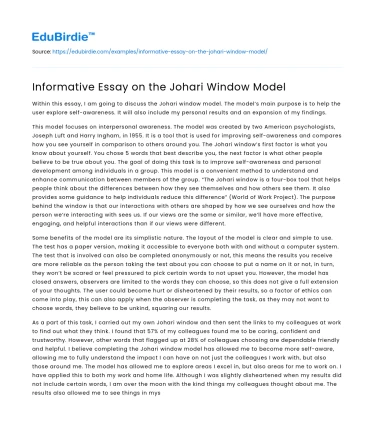Within this essay, I am going to discuss the Johari window model. The model’s main purpose is to help the user explore self-awareness. It will also include my personal results and an expansion of my findings.
This model focuses on interpersonal awareness. The model was created by two American psychologists, Joseph Luft and Harry Ingham, in 1955. It is a tool that is used for improving self-awareness and compares how you see yourself in comparison to others around you. The Johari window’s first factor is what you know about yourself. You chose 5 words that best describe you, the next factor is what other people believe to be true about you. The goal of doing this task is to improve self-awareness and personal development among individuals in a group. This model is a convenient method to understand and enhance communication between members of the group. “The Johari window is a four-box tool that helps people think about the differences between how they see themselves and how others see them. It also provides some guidance to help individuals reduce this difference” (World of Work Project). The purpose behind the window is that our interactions with others are shaped by how we see ourselves and how the person we’re interacting with sees us. If our views are the same or similar, we’ll have more effective, engaging, and helpful interactions than if our views were different.
Save your time!
We can take care of your essay
- Proper editing and formatting
- Free revision, title page, and bibliography
- Flexible prices and money-back guarantee
Some benefits of the model are its simplistic nature. The layout of the model is clear and simple to use. The test has a paper version, making it accessible to everyone both with and without a computer system. The test that is involved can also be completed anonymously or not, this means the results you receive are more reliable as the person taking the test about you can choose to put a name on it or not, in turn, they won’t be scared or feel pressured to pick certain words to not upset you. However, the model has closed answers, observers are limited to the words they can choose, so this does not give a full extension of your thoughts. The user could become hurt or disheartened by their results, so a factor of ethics can come into play, this can also apply when the observer is completing the task, as they may not want to choose words, they believe to be unkind, squaring our results.
As a part of this task, I carried out my own Johari window and then sent the links to my colleagues at work to find out what they think. I found that 57% of my colleagues found me to be caring, confident and trustworthy. However, other words that flagged up at 28% of colleagues choosing are dependable friendly and helpful. I believe completing the Johari window model has allowed me to become more self-aware, allowing me to fully understand the impact I can have on not just the colleagues I work with, but also those around me. The model has allowed me to explore areas I excel in, but also areas for me to work on. I have applied this to both my work and home life. Although I was slightly disheartened when my results did not include certain words, I am over the moon with the kind things my colleagues thought about me. The results also allowed me to see things in myself that I had not seen before, enhancing my understanding of myself.
To conclude, I would recommend the Johari window to my colleagues and to anyone who would like to become self-aware. The test’s simplistic nature makes it universal and easy to use. It has greatened my understanding of myself. Although the test can be considered closed, it allows your results to be compared without having an endless about of results. I believe the Johari model can benefit almost any working environment, and I will certainly be completing it with my other colleagues.






 Stuck on your essay?
Stuck on your essay?

